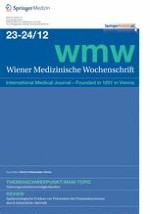01.12.2012 | themenschwerpunkt
Mechanisms and risk factors for type 1 food allergies: the role of gastric digestion
Erschienen in: Wiener Medizinische Wochenschrift | Ausgabe 23-24/2012
Einloggen, um Zugang zu erhaltenSummary
True food allergens are considered as digestion stable proteins, which are absorbed through the gastrointestinal epithelium in an intact form leading to sensitization and causing systemic symptoms. According to classifications, allergens, which are digestion-labile, cause local symptoms by their cross-reactivity towards inhalative allergens. Our recent studies revealed that digestion labile allergens can also have sensitizing capacity if gastric digestion is hindered. The increase of gastric pH via acid-suppression by proton pump inhibitors, sucralfate or antacids, interferes with protein digestion, and leads to sensitization and allergic reaction in mouse models as well as in human patients. Furthermore, the inhibition of digestion increases the risk for anaphylactic responses in sensitized individuals.
Even though also other factors, such as sphingolipid metabolites, are associated with the development of food allergies, it is without any doubt that the stomach has an important gate keeping function against food allergies.
Anzeige
